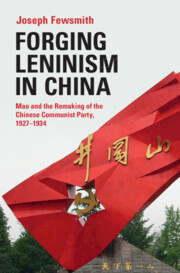Book contents
- Forging Leninism in China
- Forging Leninism in China
- Copyright page
- Dedication
- Contents
- Figures
- Maps
- Acknowledgments
- Introduction
- 1 Disaster and Local Rebellion
- 2 The Donggu Revolutionary Base Area
- 3 A Different Approach to Revolution
- 4 Mao versus Local Forces
- 5 The Logic of Sufan
- Conclusion
- Glossary
- Bibliography
- Index
2 - The Donggu Revolutionary Base Area
Published online by Cambridge University Press: 03 February 2022
- Forging Leninism in China
- Forging Leninism in China
- Copyright page
- Dedication
- Contents
- Figures
- Maps
- Acknowledgments
- Introduction
- 1 Disaster and Local Rebellion
- 2 The Donggu Revolutionary Base Area
- 3 A Different Approach to Revolution
- 4 Mao versus Local Forces
- 5 The Logic of Sufan
- Conclusion
- Glossary
- Bibliography
- Index
Summary
Chapter Two lays out the history of the Donggu Revolutionary Base Area. It emphasizes some of the unique characteristics of this place – its relative isolation nestled in the mountainous countryside of eastern Ji’an county, the close ties among a number of classmates, and the ties of kinship that made their alliance with local bandits possible. This core leadership group was able to stay together even after their original leader, Lai Jingbang, was killed. Lai was replaced by Li Wenlin, a graduate of Whampoa Military Academy, who led the Donggu Revolutionary Base area to expand to cover some 24 townships in the area.
- Type
- Chapter
- Information
- Forging Leninism in ChinaMao and the Remaking of the Chinese Communist Party, 1927–1934, pp. 47 - 69Publisher: Cambridge University PressPrint publication year: 2022

